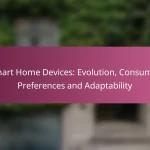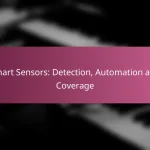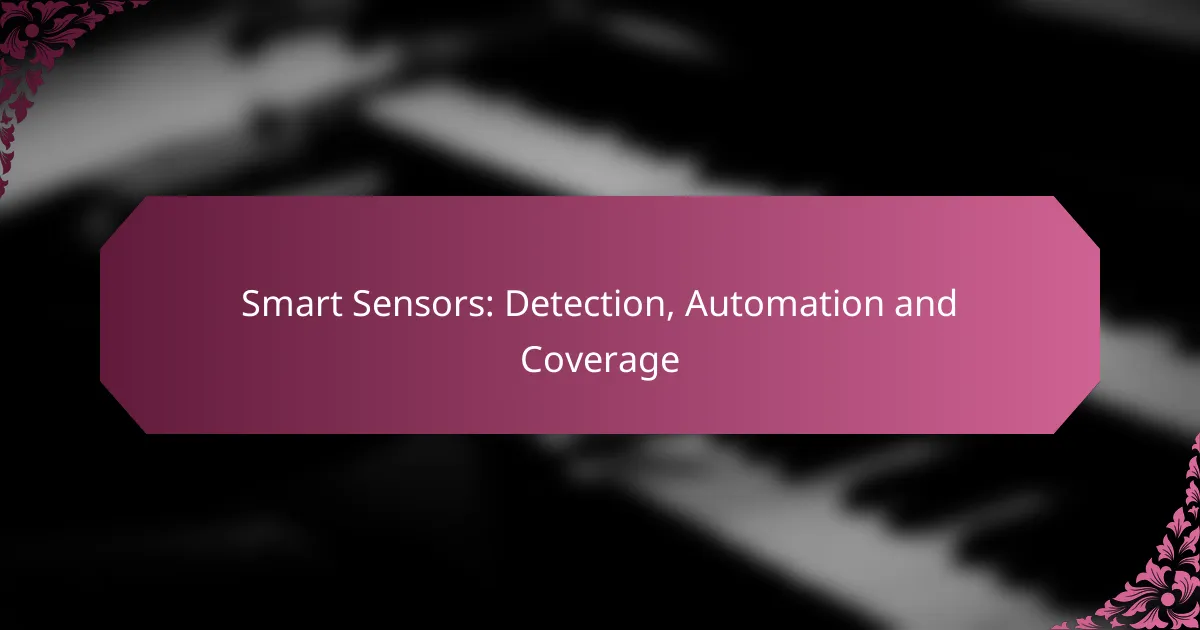Smart sensors are innovative devices that enhance detection, automation, and coverage across various applications, particularly in home automation. By integrating features like wireless connectivity and energy efficiency, they provide real-time monitoring and immediate responses to environmental changes, significantly improving security and convenience in smart home environments.
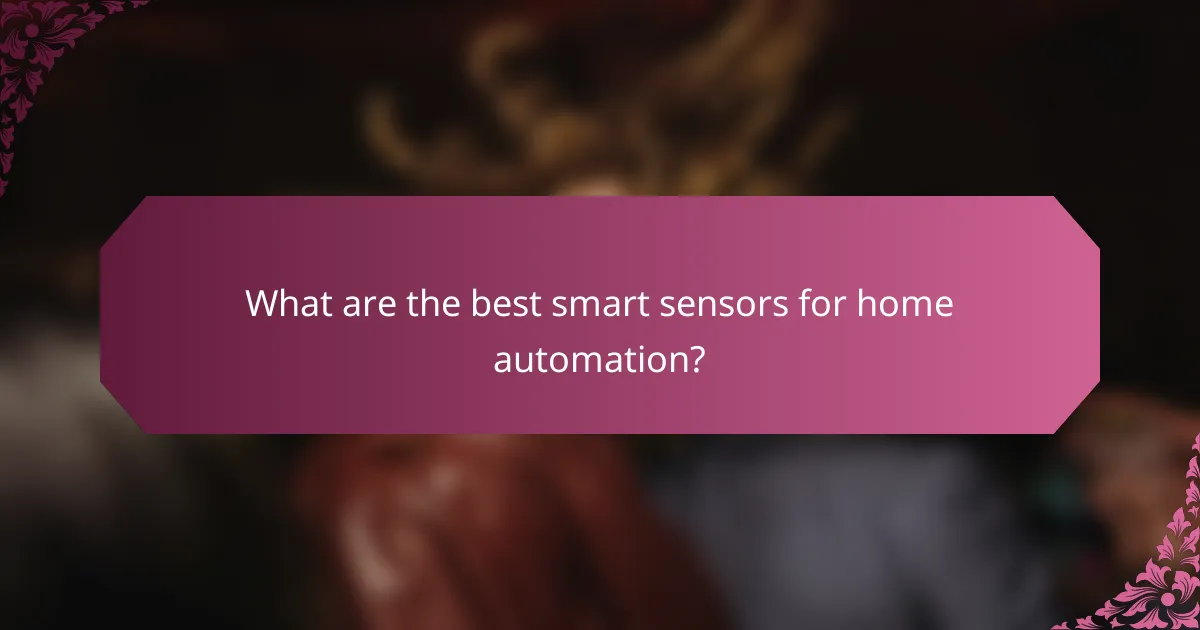
What are the best smart sensors for home automation?
The best smart sensors for home automation enhance convenience, security, and energy efficiency. Key options include motion sensors, temperature sensors, and smart locks, each offering unique features that cater to different needs in a smart home environment.
Philips Hue Motion Sensor
The Philips Hue Motion Sensor is designed to detect movement and adjust lighting accordingly. It connects seamlessly with the Philips Hue ecosystem, allowing for automated lighting based on occupancy.
This sensor is battery-operated and can be placed anywhere in your home. It offers a range of about 5 to 10 meters and can be configured to trigger specific light settings, providing both convenience and energy savings.
Ecobee SmartSensor
The Ecobee SmartSensor is primarily a temperature sensor that works with Ecobee thermostats to optimize heating and cooling. It helps maintain comfort by detecting occupancy and adjusting the temperature based on where people are in the home.
With a range of up to 60 feet, this sensor can be placed in various rooms. It also features a built-in occupancy sensor that can trigger your HVAC system to save energy when rooms are unoccupied.
August Smart Lock Pro
The August Smart Lock Pro enhances home security by allowing keyless entry through your smartphone. It can be installed over your existing deadbolt, making it easy to upgrade your door without replacing hardware.
This smart lock integrates with various smart home systems and offers features like remote access and activity monitoring. It is compatible with most standard doors and provides a secure way to manage access for family and guests.
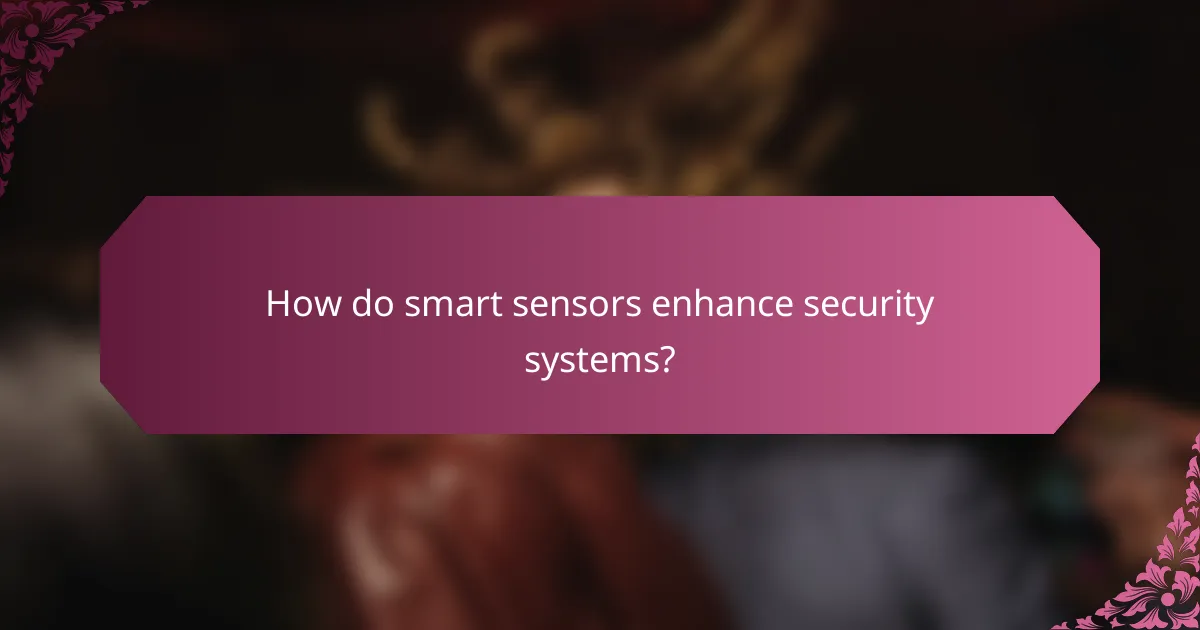
How do smart sensors enhance security systems?
Smart sensors significantly improve security systems by providing enhanced detection, automation, and coverage. They enable real-time monitoring and immediate responses to potential threats, making security more proactive and effective.
Real-time alerts
Real-time alerts are a critical feature of smart sensors, allowing users to receive immediate notifications about security breaches or unusual activity. These alerts can be sent via mobile apps, emails, or SMS, ensuring that users are informed no matter where they are.
For effective use, configure alert thresholds based on your specific security needs. For example, set alerts for motion detection during off-hours or when doors are opened unexpectedly. This helps in minimizing false alarms while ensuring genuine threats are addressed promptly.
Remote monitoring capabilities
Remote monitoring capabilities enable users to oversee their security systems from anywhere, using smartphones or computers. This feature is particularly useful for businesses and homeowners who travel frequently or manage multiple properties.
When selecting a smart sensor system, consider options that offer high-definition video feeds and user-friendly interfaces. Many systems allow for live streaming and recorded footage access, which can be crucial for reviewing incidents or verifying alerts. Ensure your system supports secure connections to protect your data from unauthorized access.
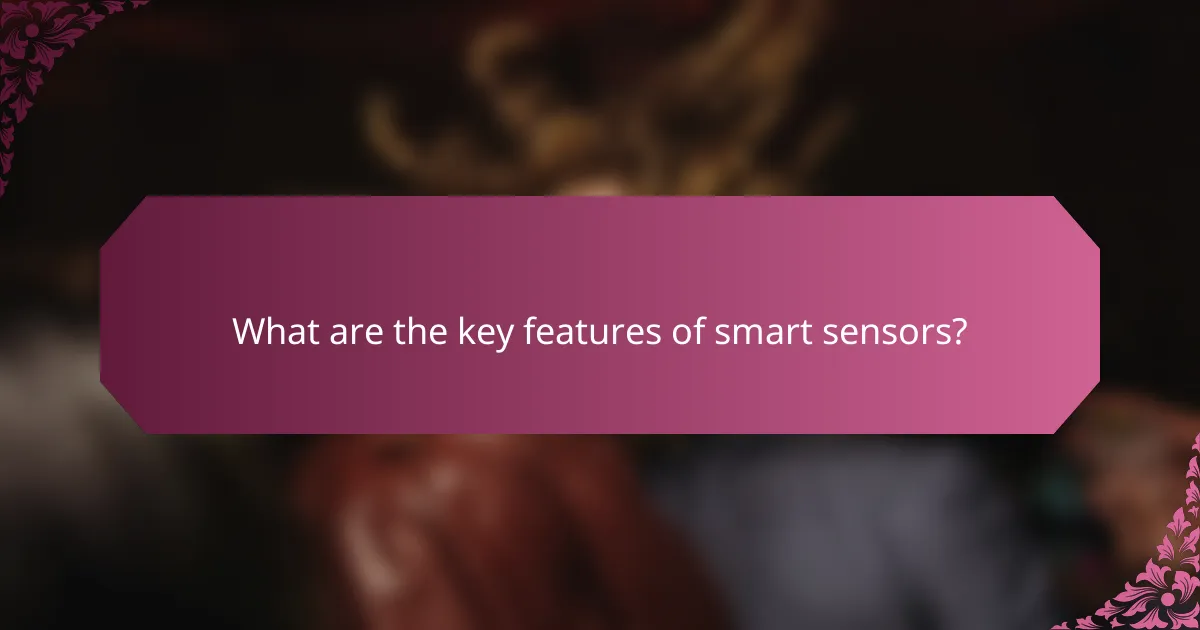
What are the key features of smart sensors?
Smart sensors are advanced devices that detect and respond to environmental changes, enabling automation and improved coverage in various applications. Their key features include wireless connectivity, energy efficiency, and seamless integration with smart home ecosystems.
Wireless connectivity
Wireless connectivity allows smart sensors to communicate with other devices and systems without the need for physical cables. This feature enables easy installation and flexibility in placement, making it possible to monitor areas that are difficult to reach with traditional wired sensors.
Common wireless protocols used in smart sensors include Wi-Fi, Zigbee, and Bluetooth. When selecting a sensor, consider the range and compatibility with existing devices to ensure reliable communication and data transfer.
Energy efficiency
Energy efficiency is a crucial feature of smart sensors, as many are designed to operate on low power, extending battery life and reducing the need for frequent replacements. This is particularly important for sensors deployed in remote or hard-to-access locations.
Look for sensors that utilize energy-saving technologies such as sleep modes or energy harvesting. These features can significantly lower operational costs and enhance the sustainability of smart sensor networks.
Integration with smart home ecosystems
Smart sensors can integrate with various smart home ecosystems, allowing for centralized control and automation. This integration enhances user experience by enabling sensors to work together, triggering actions based on specific conditions detected by one or more devices.
When choosing smart sensors, ensure they are compatible with your existing smart home platforms, such as Google Home, Amazon Alexa, or Apple HomeKit. This compatibility will maximize functionality and streamline your home automation efforts.
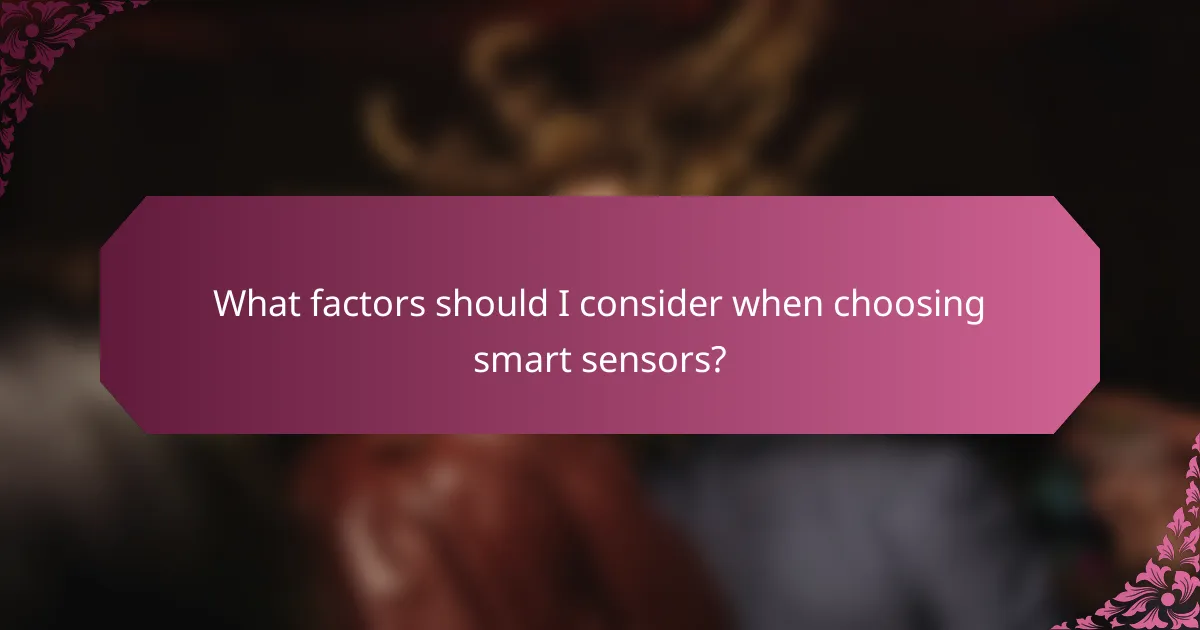
What factors should I consider when choosing smart sensors?
When selecting smart sensors, consider compatibility with existing devices, sensor range, and coverage. These factors will significantly impact the effectiveness and efficiency of your automation systems.
Compatibility with existing devices
Ensure that the smart sensors you choose are compatible with your current technology stack. This includes checking for support of common communication protocols such as Zigbee, Z-Wave, or Wi-Fi. Incompatible devices can lead to integration issues and increased costs for additional hardware.
Additionally, consider the manufacturer’s ecosystem. Some brands offer a suite of devices that work seamlessly together, which can simplify management and enhance functionality. Look for sensors that can easily connect to your existing smart home or industrial automation systems.
Sensor range and coverage
The range and coverage of smart sensors are crucial for effective monitoring and automation. Assess the area that needs to be covered and choose sensors with a range that meets your requirements. For example, indoor sensors may have a range of up to 30 meters, while outdoor sensors can often cover larger areas.
Keep in mind that physical obstacles like walls and furniture can reduce the effective range. Conduct a site survey to identify potential interference and ensure that the sensors can communicate effectively across the intended coverage area. This will help avoid blind spots and ensure comprehensive monitoring.
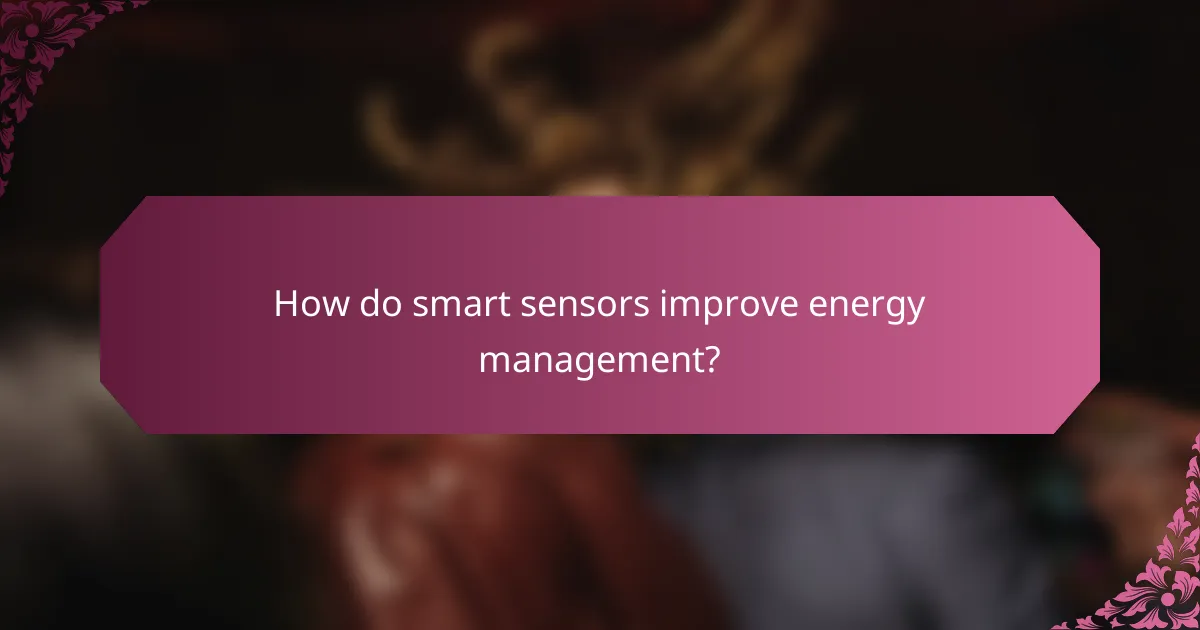
How do smart sensors improve energy management?
Smart sensors enhance energy management by automating the monitoring and control of energy usage in various environments. They provide real-time data, enabling more efficient energy consumption and reducing waste.
Automated lighting control
Automated lighting control systems use smart sensors to adjust lighting based on occupancy and natural light levels. For instance, in an office, lights can automatically turn off when no one is present or dim when sufficient daylight is available, leading to significant energy savings.
To implement automated lighting, consider using motion sensors and daylight sensors. Ensure that the sensors are calibrated correctly to avoid false activations, which can lead to unnecessary energy use. Regular maintenance is also essential to keep the system functioning optimally.
Temperature regulation
Smart sensors play a crucial role in temperature regulation by monitoring indoor climates and adjusting heating, ventilation, and air conditioning (HVAC) systems accordingly. This can result in lower energy bills and a more comfortable environment, as the system only operates when needed.
For effective temperature regulation, use smart thermostats that learn user preferences and adjust settings automatically. It’s advisable to set temperature thresholds that align with energy-saving guidelines, such as maintaining a range of 20-22°C (68-72°F) during the day and slightly lower at night. Regularly check sensor placements to ensure accurate readings and avoid energy wastage.
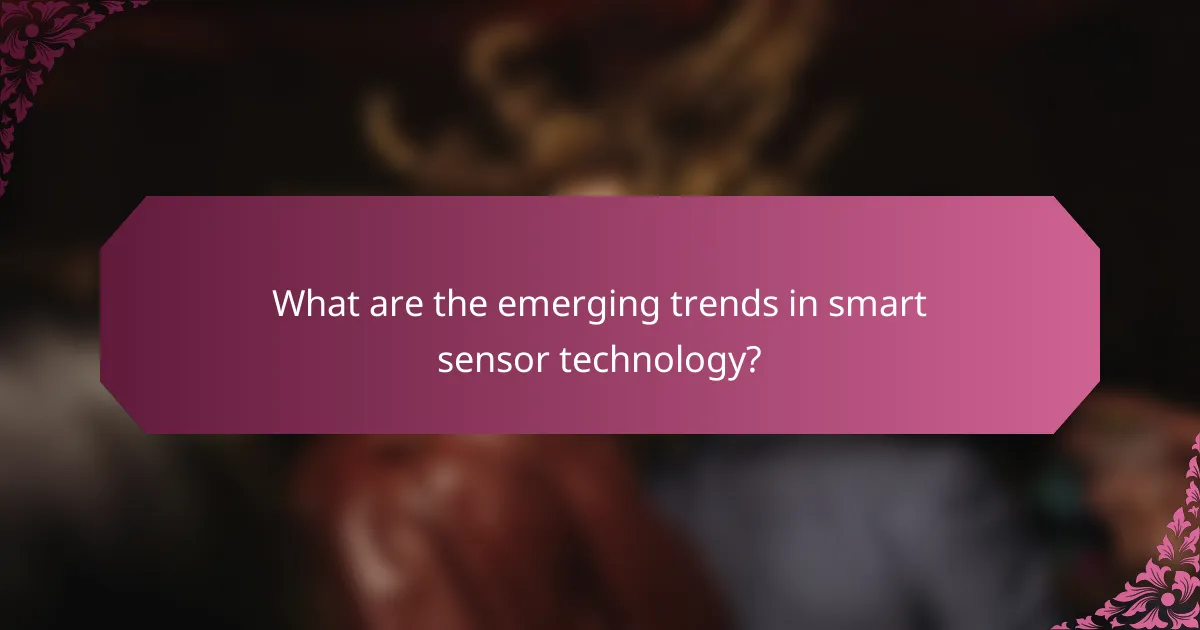
What are the emerging trends in smart sensor technology?
Emerging trends in smart sensor technology include advancements in AI-driven analytics and increased interoperability among devices. These trends enhance the capabilities of smart sensors, allowing for more efficient data processing and seamless integration across various platforms.
AI-driven analytics
AI-driven analytics in smart sensors enable real-time data processing and decision-making. By leveraging machine learning algorithms, these sensors can identify patterns and anomalies, improving predictive maintenance and operational efficiency.
For instance, in industrial settings, AI can analyze sensor data to predict equipment failures before they occur, potentially saving companies significant costs in downtime. This capability is becoming increasingly vital as industries seek to optimize their operations and reduce waste.
Increased interoperability
Increased interoperability among smart sensors allows different devices and systems to communicate and work together seamlessly. This trend is crucial for creating integrated smart environments, such as smart homes and smart cities, where various sensors can share data and insights.
For example, a smart thermostat can interact with motion sensors and weather data to optimize heating and cooling, leading to energy savings. Ensuring that devices adhere to common standards, such as Zigbee or Z-Wave, can facilitate this interoperability and enhance user experience.

How do smart sensors impact environmental sustainability?
Smart sensors significantly enhance environmental sustainability by optimizing resource use and reducing waste. They enable real-time monitoring and automation, leading to more efficient energy consumption and lower emissions across various sectors.
Reduction in energy consumption
Smart sensors contribute to energy savings by providing precise data on usage patterns and environmental conditions. For instance, in smart buildings, sensors can adjust lighting and heating based on occupancy, potentially reducing energy consumption by 20-30%.
These devices can also facilitate demand response programs, where energy usage is adjusted during peak times to alleviate strain on the grid. This not only lowers costs for consumers but also minimizes the need for additional power generation, which often relies on fossil fuels.
When implementing smart sensors, consider integrating them with existing energy management systems for maximum efficiency. Regular maintenance and updates are crucial to ensure sensors function optimally and continue to provide accurate data over time.


